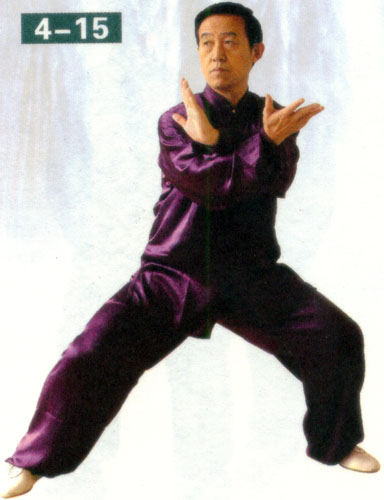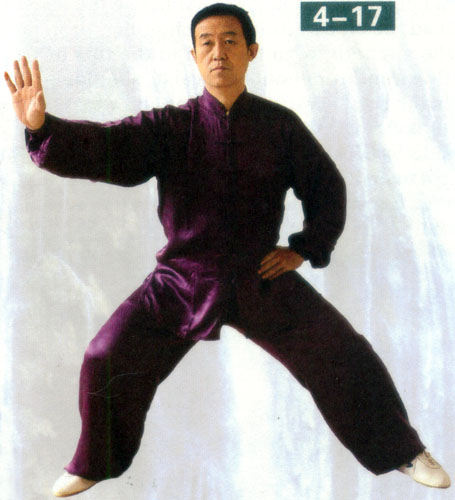Form 3: Lazy About Tying Coat
1) Turn the body slightly to the left and transfer the weight to the right leg. Change the right fist into a palm that moves to the left a little, then upward and right in a circle to the front right side of the head. Throughout this movement, the right arm rotates counter clockwise and the left palm rotates clockwise to press down to the side of the left hip. Eyes look forward left. (Figure 4- 14)

Key Requirements to the Movement:
In order to use the body to lead the arm movement, the waist should be sunk and should turn before the right palm pushes up in a circle. The right palm movement should be coordinated with the movement of the left palm pressing down to generate an "opening strength". Breathe in slowly.
2) The right arm rotates clockwise and the palm moves a little to the right, and then presses down in a circle across the front of the body. Finally, bring the right arm in front of the left chest with the palm facing upward. The left palm pushes to the left and then rotates up counter clockwise in a circle and crosses with the right arm in front of the chest. The left arm stays on top of the inner right forearm with the left palm facing outwards. Transfer the weight on to the left leg and lift the right foot up to take a large step out to the right. When the foot moves, keep the inside of the right heel sliding on the floor with the toes lifted and turned inward. Eyes look right. (Figure 4-15)

Key Requirements to the Movement:
The step out should be coordinated with the crossing of both arms in front of the chest and the arm and foot movements should occur simultaneously and finish at the same time. The step out should be very light, natural and sensitive. Breathe out during this movement. Click here to learn Joint tuberculosis in TCM.
3) Turn the upper body to the left and transfer the weight to the right. The right palm rotates clockwise and then moves to the left a little and pushes upward. Eyes look forward and right. (Figure 4-16)
Key Requirements to the Movement:
When transferring the weight, the hips move in an arc to the rear. Maintain the "outward push strength" through the left elbow and right arm keeping space between the arms and the body - the armpits should be free and in a rounded shape. Breathe in during this movement.
4) Turn the upper body to the right and rotate the right arm counter clockwise. The right palm pushes up and forward to the right in an arc to cross the front of the body until it is above the right knee with the fingers at eye level. The left palm rotates back slightly at the end of the movement and the body sinks down and turns back to the front. Keep the shoulders relaxed and the elbows lowered. The left arm rotates counter clockwise and moves down in a circle across the abdomen until it reaches the left side of the waist; then rotating clockwise put the left palm on the left side of your waist, clockwise put the left palm on the left side of your waist, with the thumb at the back and fingers at the front. The weight is on the right leg. Eyes follow the right hand during the movement then look forward at the end of movement. (Figure 4-17)

Key Requirements to the Movement:
When pushing the right palm, use the waist to lead the shoulder and shoulder to lead the elbow. Relax the shoulder, drop down the elbow and the wrist, to allow the strength to go through to the tips of fingers. The internal energy should be flowing throughout the waist, shoulders, arms and ultimately to the fingertips. In the final position, the hips and waist are relaxed, the groin open, the shoulders sunk down and the elbows low. A greater percentage of the weight is on the right side and less weight on the left side with the right knee over the right heel (do not over-bend the knee). The left leg extends with the knee bent slightly and left toes turned inward. The torso is naturally upright free and comfortable. Breathe out during this movement. Click here to learn Rheumatic Arthritis in TCM.

![Diseases, Symptoms, tcm, [tcmwindow.com]](/uploadFile/adImg/2015/4/24/6de633b8-0a7a-4546-868a-02389edf5c65.png)





